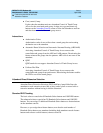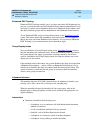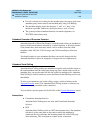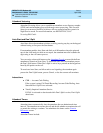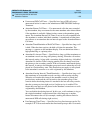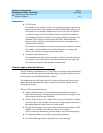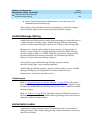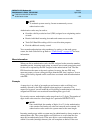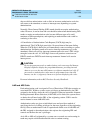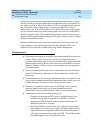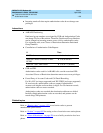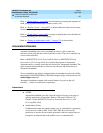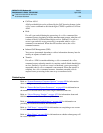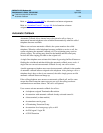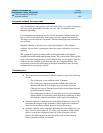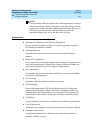
DEFINITY ECS Release 8.2
Administrator’s Guide
555-233-506
Issue 1
April 2000
Features and technical reference
1154Authorization codes
20
does not dial an authorization code or dials an incorrect authorization code, the
call routes to the attendant, or routes to intercept tone, depending on system
administration.
Normally, Direct Inward Dialing (DID) trunks should not require authorization
codes. However, it can be done and care should be taken when administering DID
trunks to require an authorization code, because different type calls could
terminate at different endpoints, and requiring an authorization code could be
confusing to the caller.
A Cancellation of Authorization Code Request (CACR) digit may be
administered. The CACR digit cancels the 10-second interval between dialing.
When the CACR digit is dialed, the call immediately routes according to system
administration. (Incoming trunk calls receive intercept treatment or go to the
attendant.) Other calls receive intercept treatment unless the user’s FRL is high
enough to route the call. A CACR digit from an off-premises extension over
DID/Tie trunks use DID/Tie trunk intercept treatment. Internal calls receive
intercept tone.
!
CAUTION:
Do not program passwords or authorization codes onto auto dial buttons.
Display telephones display the programmed buttons, providing internal
abusers access to the auto dial buttons to originate unauthorized calls. If
passwords or authorization codes must be programmed onto auto dial
buttons, use the ~s (suppress) character to prevent displaying the codes.
For more information, refer to BCS Products Security Handbook.
AAR and ARS Calls
Each authorization code is assigned a Class of Restriction (COR) that contains an
associated FRL. Within a system, access privileges are determined by the FRL
assigned to the facility where the call is originated. When an Automatic Alternate
Routing/Automatic Route Selection (AAR/ARS) call is dialed, the system allows
or denies the call based on the FRL of the originating station. COR is used to
restrict internal or non-AAR/ARS calls.
Authorization codes are given to individual users and provide a method of
specifying the level of calling privileges for that user regardless of the originating
facility. Once an authorization code is required and dialed on an AAR/ARS call,
the FRL assigned to the authorization code replaces the originating FRL and
controls and defines the user’s privileges.
An AAR or ARS call originated by a system user or routed over an incoming tie
trunk may require a dialed authorization code to continue routing.



